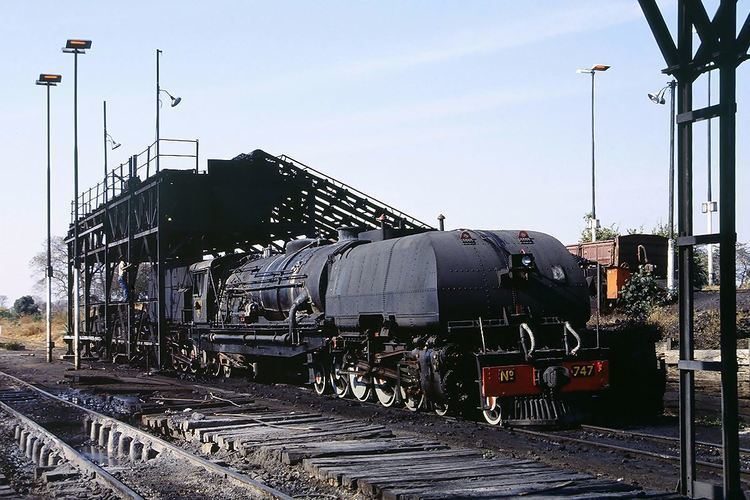Power type Steam Total produced 61 UIC class (2′D1′)(1′D2′) h4t | Build date 1954–1958 Configuration 4-8-2+2-8-4 | |
 | ||
Builder Beyer, Peacock and Company | ||
The Rhodesia Railways 20th class, later Zambia Railways and National Railways of Zimbabwe 20th classes, were among the largest and most powerful steam locomotives in the southern hemisphere.
Contents
With 61 locomotives built, they were the fourth largest class of Garratt locomotive built – after the South African Railways class GMA, (120), the Rhodesia Railways 15th class, (74) and the South African Railways class GF (65).
Design
The locomotives have a 4-8-2+2-8-4 of "Double Mountain" wheel arrangement. This arrangement was also used by most other large Garratts.
The 20th class was the first and only class of Rhodesia Railways locomotives to be fitted with mechanical stokers. Other technical features included bar frames and thermic syphons.
The later locomotives were classified as 20A class; the main difference being that the 20ths' inside and outside trailing wheels were of the same size, on the 20A, the inside trailing wheels diameter had been increased in size. The 20As were also heavier.
The 20th class also had the round-ended bunkers characteristic of late Garratts.
The early years
The initial use of the 20th class was ill-fated. The locomotives were plagued with teething troubles including cracks in the locomotives' frames and fireboxes. Unlike the South African Railways' GMA, which had cast steel frames, the 20th had conventional fabricated bar frames.
Two locomotives were scrapped very early due to accident damage. Strangely, they were the first (700) and the last (760) built.
Apart from these problems, the locomotives met all expectations. They were by far the most powerful locomotives on the Rhodesia Railways, and were rated to pull 1,250 long tons (1,270 t) up a 1.55% (1 in 64) incline.
Later service
In 1964, Zambia took over the operation of railways in its territory. This included the transfer of 80–90 locomotives – about half of them 20th and 20A class locomotives. This left only fifteen 20ths in [Southern] Rhodesia. They later re-acquired four from Zambia Railways when the latter dieselised.
These nineteen locomotives were 705, 707, 709, 710, 714, 716, 717 and 718 (20th) and 723, 724, 726, 727, 729, 738, 746, 747, 749, 753 and 756 (20A) were mainly used in the transportation of coal between Thomson Junction to Bulawayo and Victoria Falls. On this route they were rated with a maximum load of 1,600 long tons (1,630 t).
In Zambia, the 20th class was replaced by diesels and retired by about 1970.
By June 1975, there were only 18 in service in Rhodesia, all allocated to Bulawayo.
Rebuilding
In 1978 Rhodesia Railways started a rebuilding program for its steam locomotive fleet. Between 1980 and 1983 the remaining Garratt locomotives were completely overhauled and had some modernisation, including the installation of roller bearings. The work was undertaken by private companies, especially the RESSCO works in Bulawayo.
Work on the first two was completed in 1980, although it was April 1983 before they were all dealt with.
As part of the rebuilding programme, the locomotives' running numbers were consolidated into two blocks: 730–737 (20th) and 740–750 (20A). Three locomotives kept their old numbers: 746, 747, and 749. At the same time, the locomotives received names; the cast nameplate were applied to the cabside above the numberplate.
Post rebuilding service
All the rebuilt 20th and 20A locomotives were allocated to Bulawayo.
Due to the continuing difficult economic situation in Zimbabwe, the rebuilt steam locomotives remained in service longer than originally planned. Finally, in the early 1990s, new diesels were ordered and the locomotives were systematically withdrawn as they became due for general overhaul. All were withdrawn from general service by 1994.
All those allocated to Bulawayo with the exception of 730/736/740/749 were then put up for tender and scrapped.
Fate
Some locomotives are preserved in museums or plinthed as monuments.
